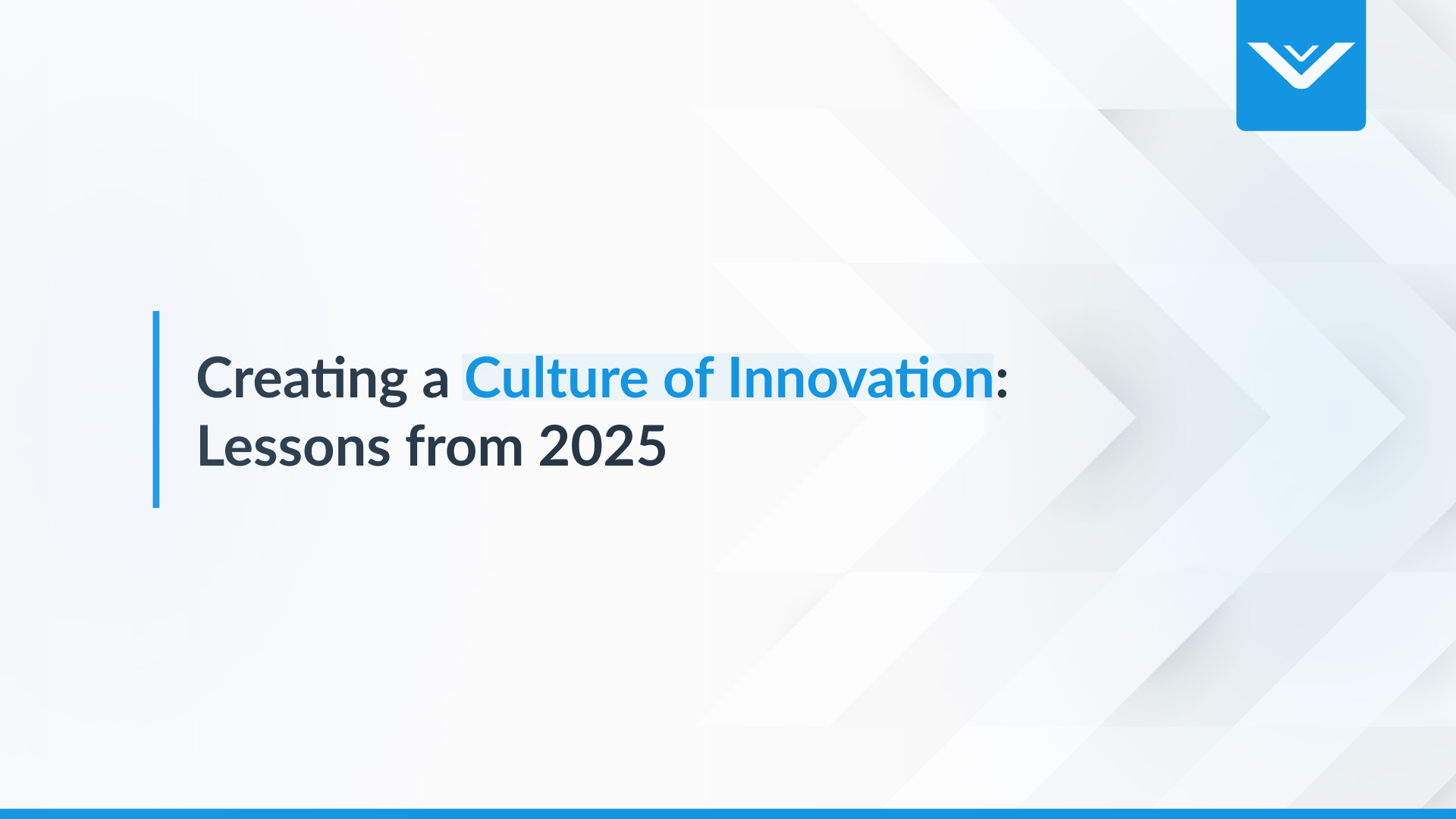

Creating a culture of innovation means staying curious, supporting teams through uncertainty, and continuously raising the bar for what’s possible. The technology will keep changing. The pace will keep accelerating. But organizations that invest in their people and cultivate the right culture will always find their next summit and the energy to climb it.
Creating a Culture of Innovation: Lessons from 2025
Every organization is chasing innovation, but only a few are building the culture to sustain it. Across industries, leaders are learning that technology sets transformation in motion, but it’s the people behind it who determine whether change takes hold and creates lasting impact.
Over the past year, enterprises have faced a defining moment. Artificial intelligence has pushed transformation efforts into new territory, forcing organizations to confront what change truly requires. Some have accelerated adoption and reaped early gains, while others have stalled under the weight of complexity, hesitation, or cultural resistance. The difference often comes down to mindset.
To explore how companies can move beyond experimentation and create real change, we sat down with Frank Daidone, Chief Operating Officer and SVP of Client Transformation. With experience as both a CIO and CEO, Frank has led large-scale digital transformations across private, public, and nonprofit sectors, guiding organizations through the intersection of technology, culture, and leadership.
This conversation looks back at what enterprises experienced throughout 2025 and what it revealed about building adaptable, innovative organizations. It highlights what worked, what didn’t, and the lessons executives should take into the next wave of transformation.
“Every organization we work with is embracing innovation. It’s not easy, but the energy is there. People are showing up every day wanting to create change.” – Frank Daidone, Chief Operating Officer and SVP of Client Transformation, Vation Ventures
Key takeaways
- Culture determines velocity. Technology may accelerate transformation, but culture decides how far it goes. Organizations that prioritize communication and trust adapt faster.
- Innovation starts small. Pilots create proof, confidence, and champions—turning isolated experiments into enterprise-wide change.
- Managers multiply impact. Strong leadership at every level translates vision into action, sustaining momentum through clarity and consistency.
- Empowerment drives adoption. When employees are trusted to test, learn, and contribute ideas, innovation becomes part of daily work.
- Leadership sets the tone. The most innovative organizations are led by people who listen first, communicate often, and stay humble enough to keep learning.
Digital Transformation in 2025
Looking back on 2025, transformation didn’t arrive with the flash of something entirely new. Instead, it echoed moments we’ve seen before. The rapid rise of artificial intelligence has created the same sense of uncertainty and potential that once came with the arrival of broadband, the cloud, or the first iPhone. Each of those moments redefined how organizations operated, and each time, leaders faced the same questions: What does this mean for us? How fast should we move? Are we ready?
Frank described this year as another pivotal inflection point, one that has exposed both the urgency and the unevenness of transformation across industries. Through his work with clients, three distinct approaches have emerged:
- The Embracers: Organizations leaning in and experimenting with AI, eager to learn through pilots and small wins.
- The Cautious Planners: Those taking a measured approach, building governance and frameworks before diving in.
- The Skeptics: Teams dismissing AI as a temporary trend, often saying, “We have day jobs and don’t have time for this,” and waiting for others to prove its value.
The takeaway is clear: readiness for transformation is not about resources or technology access. It’s about perspective. Organizations that see innovation as an extension of their culture are already finding ways to learn and adapt, while those waiting for the perfect moment risk being left behind.
“Nobody’s losing their job tomorrow because of AI. But it will make your job a lot easier or a lot harder depending on your willingness to adapt,” – Frank Daidone, Chief Operating Officer and SVP of Client Transformation, Vation Ventures
This year’s transformation story is not about the tools themselves, but about what they reveal: the ability of organizations to balance experimentation with discipline, curiosity with caution, and bold ideas with clear purpose.
The Management Multiplier: Why People and Culture Make or Break Transformation

When asked why people and culture play such a defining role in transformation, the answer was immediate. Technology may spark change, but people decide whether it sticks.
Across many of our client engagements, the pattern has been the same. End users adopt faster than their organizations. Employees experiment with new tools, find creative shortcuts, and look for ways to make their work easier. Meanwhile, leadership teams are still designing governance frameworks, evaluating risk, or debating timing. The result is a widening gap between those eager to move and those hesitant to act.
It's a difference between inertia and momentum. In most periods of transformation, employees have led the charge long before enterprises caught up. The same is true now with AI. The organizations that thrive are those that recognize this bottom-up energy and channel it into something productive.
“Your end users will always adopt faster than your organization. Culture is what determines whether that energy becomes innovation or frustration.” - Frank Daidone, Chief Operating Officer and SVP of Client Transformation, Vation Ventures
Culture, Frank explains, is built on communication and trust. When leaders clearly define their organization’s “North Star” and reinforce it consistently, employees understand how their ideas connect to the larger mission. That connection is what empowers people to experiment responsibly, identify real opportunities, and communicate what’s working.
But culture isn’t set by the C-suite alone. It scales, or stalls, through team leaders. Managers are the ones who interpret vision, translate strategy, and keep teams aligned as change unfolds. When that layer is strong, transformation accelerates. When it’s overlooked, even the best strategies lose momentum.
He often gauges an organization’s cultural health by a single metric: management turnover. If managers aren’t supported, engaged, or empowered, communication breaks down. When they are, they become the true champions of innovation that keep teams focused, connected, and confident through change.
Building a Culture of Innovation: From Pilots to Empowerment

When asked how organizations can move from talking about innovation to truly embedding it, Frank described it as hard work that starts small and scales with purpose. Transformation isn’t a single project or program, but a continuous process of learning, testing, and improving.
The best organizations approach innovation like a pilot, not a mandate. They begin with a clear idea, test it in low-risk environments, and gather real feedback before expanding. Those early pilots serve two purposes: they prove value and they build confidence. Once something works, it becomes easier to replicate, and the people who led it become internal champions for change.
“You can’t force innovation on people. You pilot it, you prove it, and you let your champions lead the way.” - Frank Daidone, Chief Operating Officer and SVP of Client Transformation, Vation Ventures
Here are ways organizations can turn experimentation into lasting culture:
- Start with clarity. Define what problem you’re solving and why it matters to the business. Every pilot should connect directly to organizational goals.
- Test in safe spaces. Begin with “friendly” teams—groups open to feedback and willing to help shape the outcome.
- Measure and learn. Track what works and what doesn’t. Success is proof of concept, but failure is data too.
- Empower champions. Highlight early adopters and give them a platform to share lessons across the organization.
- Expand thoughtfully. Once a pilot succeeds, move it into higher-impact areas before scaling company-wide.
- Invest in training. Build confidence through education and support so employees feel equipped to contribute, not afraid to try.
Frank reflected back on his time at a public health organization that wanted to reduce family attrition in care programs. By analyzing existing data, his team built a predictive analytics model that signaled when engagement was at risk. A simple, proactive phone call made all the difference. Retention rose, and the staff who tested the idea became the loudest advocates for expanding it.
The lesson applies to any organization. Innovation doesn’t need to start with something complex. It needs to start with a clear purpose, a structure for learning, and a culture that rewards curiosity. When employees feel trusted to explore and supported to grow, innovation becomes less about technology and more about continuous improvement.
One key strategy we've seen help organizations through change is by having a robust change management program. Change management is a structured approach to helping people transition through changes in tools, processes, or ways of working. In enterprise environments, it plays a critical role in ensuring that new systems are actually adopted and that the effort behind a rollout leads to long-term results. Curious about how change management works? Explore our recent Change Management Guide here.
What Makes or Breaks Innovation
.png)
When asked what most often determines whether innovation thrives or stalls, Frank provided a candid perspective. Success depends on leadership behavior, operational discipline, and the strength of the management layer that carries culture forward.
Organizations that innovate well tend to look the same on the inside: their people feel trusted, their leaders listen, and their teams know what success looks like. Those that struggle often do so for familiar reasons: poor communication, unclear priorities, or leadership egos that leave little room for collaboration.
“Check your ego at the door. Get really good people around you and listen.” - Frank Daidone, Chief Operating Officer and SVP of Client Transformation, Vation Ventures
What Makes Innovation Work
- Empowered people. Employees are encouraged to share ideas, challenge assumptions, and take ownership of improvement.
- Strong managers. The middle layer is supported, informed, and trusted to interpret strategy and translate it into action.
- Clear communication. Leaders consistently reinforce goals and repeat key messages until they become part of the culture.
- Aligned operations. Processes are stable enough to support creativity without getting in the way of it.
- Cultural fit in hiring. Teams hire for curiosity, adaptability, and collaboration, not just technical expertise.
What Breaks Innovation
- Weak management continuity. High turnover or poor communication among managers fractures alignment.
- Command-and-control leadership. Innovation stalls when people wait to be told what to do instead of being empowered to act.
- Neglecting operations. Even the most visionary ideas fail without the systems to execute them.
- Rigid egos. Leaders who believe they need all the answers create silence instead of solutions.
- Lack of follow-through. Culture changes only when actions reinforce words. Momentum fades without visible progress.
Culture doesn’t fail overnight. It erodes quietly when organizations stop listening, stop learning, or stop reinforcing what matters. The opposite is also true: when people feel supported, informed, and trusted, they’ll find ways to innovate even in the toughest conditions.
The Energy of What’s Next
As the conversation turned toward what comes next, the tone shifted from reflection to excitement. Despite the challenges of transformation, there’s a growing energy across organizations, bringing a renewed curiosity, collaboration, and desire to make progress.
“There’s an exciting buzz, especially after the recent years of the pandemic, about people reconnecting and actively collaborating, brainstorming, and working towards a brighter future rather than just trying to survive the current times.” - Frank Daidone, Chief Operating Officer and SVP of Client Transformation, Vation Ventures
Frank described this time in technology as one where innovation feels tangible again. After years of disruption and uncertainty, teams are eager to experiment, and leaders are recognizing that innovation thrives when it’s visible, celebrated, and shared.
He recalled a client who launched a “Just Fix It” program, placing QR codes across offices to collect employee ideas for improvement. Within months, the company had implemented more than 250 suggestions, each one small, but collectively transformative. The message was clear: people closest to the work often see the best opportunities to improve it.
Frank also spoke about being in the room with a utility company’s full team, celebrating milestones, recognizing achievements, and reflecting on the impact of their collective effort. The energy in that room was proof that culture and innovation are inseparable.
Conclusion

In the conversations happening across enterprises today, we see that trust, leadership, and culture make change possible. AI may be driving transformation at record speed, but what determines success still comes down to people. The organizations making real progress are those that pilot ideas, invest in their people, and give employees the confidence to lead from where they are.
“We operationalize innovation. We bring innovation out of the margins. It’s like climbing a mountain, and our job is to help organizations get to the top so they can see the next peak and say, that’s where we want to go next.” - Frank Daidone, Chief Operating Officer and SVP of Client Transformation, Vation Ventures
Creating a culture of innovation means staying curious, supporting teams through uncertainty, and continuously raising the bar for what’s possible. The technology will keep changing. The pace will keep accelerating. But organizations that invest in their people and cultivate the right culture will always find their next summit and the energy to climb it.
If your organization is exploring how to strengthen its culture of innovation or align transformation efforts with long-term strategy, our team can help. Contact us to learn how we partner with leaders to operationalize innovation, empower people, and turn vision into measurable progress.
Spread the word.
Thousands of subscribers receive our newsletter every week breaking down what's happening across the technology community.
Join them today.
Keep Reading
.png)
Change Management Guide: How to Enable Real Adoption and Long-Term Value of Your Technology Initiatives
Change is a constant in today’s enterprise environment, but successful adoption doesn’t happen on its own. Organizations that plan, structure, and support change intentionally are better equipped to see results—faster, with less disruption, and with greater alignment across teams.


.jpg)

.jpg)
